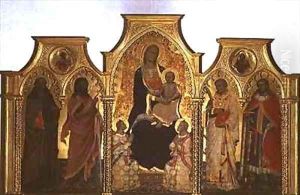Lorenzo di Niccolo Gerini Paintings
Lorenzo di Niccolò Gerini was an Italian painter active during the late Gothic period, contributing significantly to the art scene of Florence, Italy. His life and work spanned the transition from the 14th to the early 15th century, a time when the city of Florence was a crucible of artistic innovation, leading up to the Renaissance. Despite the overshadowing fame of later Renaissance artists, Lorenzo's contributions to the art world during his time were noteworthy, especially in the realms of religious art and fresco painting.
Lorenzo was born into a family of artists, which likely provided him a rich environment for honing his craft from an early age. His father, Niccolò di Pietro Gerini, was also a distinguished painter, suggesting that Lorenzo's training began within his family's workshop. This background would have immersed him in the artistic traditions of the time, as well as the technical and stylistic innovations that were beginning to emerge.
Throughout his career, Lorenzo di Niccolò Gerini collaborated with other prominent artists of his time, including Spinello Aretino, and was involved in the decoration of several important churches in Florence and its surroundings. His works are characterized by their vivid detail, vibrant colors, and the emotional expressiveness of the figures he depicted. Notable works attributed to him include frescoes in the Chapel of St. Sylvester in the Church of Santa Croce and panels in the Florence Cathedral.
Despite the significance of his contributions, Lorenzo's work has not been as extensively documented as that of his more famous contemporaries and successors. However, his artistry is recognized for its role in the development of Florentine painting, bridging the gap between the medieval Gothic traditions and the emerging Renaissance style. Lorenzo di Niccolò Gerini's death around 1412 marked the end of an era, but his artistic legacy would influence the generations of artists who followed, contributing to the rich tapestry of Italian Renaissance art.
